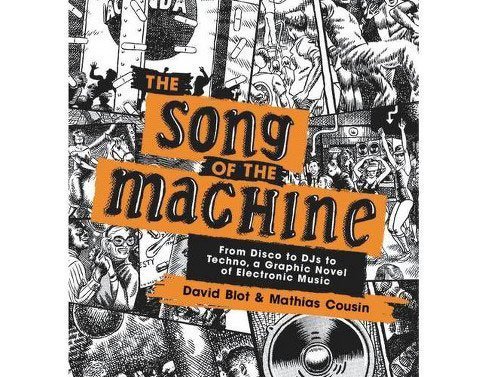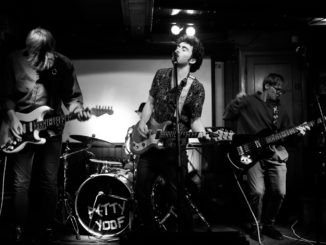
The history and development of The Song of the Machine is almost as fascinating as the book itself. Mathias Cousin thought of the idea of producing a graphic novel back in 1995 before there were any reliable books, films or documentaries on House and EDM. To judge the merits of this graphic novel, one must be mindful that both Blot and Mathias did not intend The Song of the Machine to be neither a history book nor “the truth”, but simply as “a comic book. A graphic novel!”
The Song of the Machine, which in this edition has a foreword by Daft Punk was first published in two volumes in France (the home of Daft Punk). The first six chapters are more informative, based on the duo’s own research and knowledge of music were published in 2000. Two years later, in September 2002 (sadly a month after Cousin’s death), the second part was published where the authors offer readers the contemporary real-life global experiences of working in clubs, meeting artists, DJ’s and other fly on the wall revelations.
One thing that will strike the reader immediately is the importance of location. Our authors go into detail as to how the growth of House music in France was inevitable. Firstly, the word disco is derived from the French word discothèque, which means a place where discs are stored. Secondly, the world’s first discothèque opened in Rue de la Huchette in Paris. David and Cousin argue that the roots of disco can be traced back to the 1940s and present us with the songs and artists who would lead the way. Whilst disco is popularly associated with the 1970s, the first wave of disco had actually fizzled out in the 1960s. Disco only resurfaced following the Stonewall Riots in New York in 1969 to assert LGBTQ+ rights.
From the history of disco music, we also learn the club where, according to the authors, “the history of House music began”: The Loft in Lower Manhattan, which opened in 1971. DJ’s Michael Capella and David Rodriguez are referenced as is The Loft’s first “cult” DJ, David Mancuso. The authorities would try, but fail to prosecute Mancuso. From Mancuso, we are introduced to Nicky Siano, the first DJ to be recognised by the recording industry. Our authors describe how DJ’s increasingly came into a position of power who could make or break a singer’s career. We also find learn a lot more about Frankie Knuckles beyond his music.
The 1970s would recognise Tom Moulton as the “first official recording mixer”. Disco songs on the airwaves rarely lasted longer than three minutes. In the clubs, this was far too short for any meaningful dancing to commence. Hence the twelve-inch single, which Moulton invented with Rodriguez would be associated with disco whilst the seven-inch single would be associated with pop.
David and Cousin also examine disco as a global phenomenon and how like blues and jazz music before it, disco too would be labelled as “devil music”. Disco would spread its wings globally, especially in Munich and Paris. Studio 54 (along with the celebrities who walked through its doors and the lists of their drugs of choice) and Chic’s “Good Times” (which sold six million copies in the USA alone) are celebrated. However, the growing popularity of disco would diminish and disco would officially be declared dead in 1980.
From disco, our authors take us on a road trip to Chicago, the third-largest US city and the home of House music. Felix Da Housecat is the main House DJ featured in this graphic novel. The growth of House music in Chicago encouraged Frankie Knuckles to relocate to this city. Post- disco New York turned to funk, whilst, In Chicago, Knuckles remixed disco numbers “with longer breaks”, where the music he played at The Warehouse would be “a haven for Chicago’s black LGBTQ community. In 1983, Knuckles went on to open his own club: The Power Plant.
House music would flourish thanks to HOT MIX 5 on Radio 102.7 which allowed House music to be heard during the day as well as at night-time. Sadly, Chicago and House music, like disco before it would come face to face with its problems such as the reluctance of record labels to promote house music and the dominant labels that did (TRAX Records and D.J. International Records), had a reputation for not treating their signed artists fairly. This created a brain drain of artists who left for New York. As a result, by 1990, Chicago “was a ghost town”.
We also learn about Detroit and Manchester, England and how both these cities were influenced indirectly by Kraftwerk. The story of Manchester is the story of “how rockers discovered dance music”. Naturally, Joy Division and New Order (who our authors are colossal fans of) are examined as are Depeche Mode and The Human League. The progress of New Order post “Blue Monday (the biggest selling twelve-inch single of all time) and their work with Electro pioneer Arthur Baker is narrated. The (now closed) The Haçienda night club is both celebrated and mourned.
The Criminal Justice Act, 1994, “banning public gatherings” which “effectively put an end of rave parties” is discussed. The idea that emerged during the 1980s that clubbing outside is better than inside any club is addressed as is the cocktail of ecstasy and raves which led to a techno explosion in Europe. Our authors examine how UK House was imported from the USA (particularly Chicago).
As well as the increased use of colour in the illustrations in the second volume, our authors cover Gospel House and drum ‘n’ bass. Readers are also given bonus features which didn’t feature in the initial two-part release, including, when the duo met and saw New Order play in Liverpool in 2001. There is also an afterword by David Blot who references Wiley (who has collaborated with Wayne Paul) and Wiley’s 2004, “Wot Do U Call It?” track. In Blot’s essay, David offers heartfelt, intelligent discussion of electronic music that puts his knowledge on a par with Sir John Peel.
The Song of the Machine does not serve as the most valuable a reference point. Theft! A History of Music is more credible in this respect. However, as discussed, this was never David and Cousin’s intention. The Song of the Machine proves that when it comes to various genres of music, the UK is a nation of immigrants. The UK celebrates this fact well, and as a result, has, and continues to have its own global musical impact. It is therefore sacrosanct that more music-related graphic novels are translated into the English language and released to English speaking communities globally.
The Song of the Machine can be purchased via https://www.blackdogandleventhal.com/titles/david-blot/the-song-of-the-machine/9780316526241/




Be the first to comment